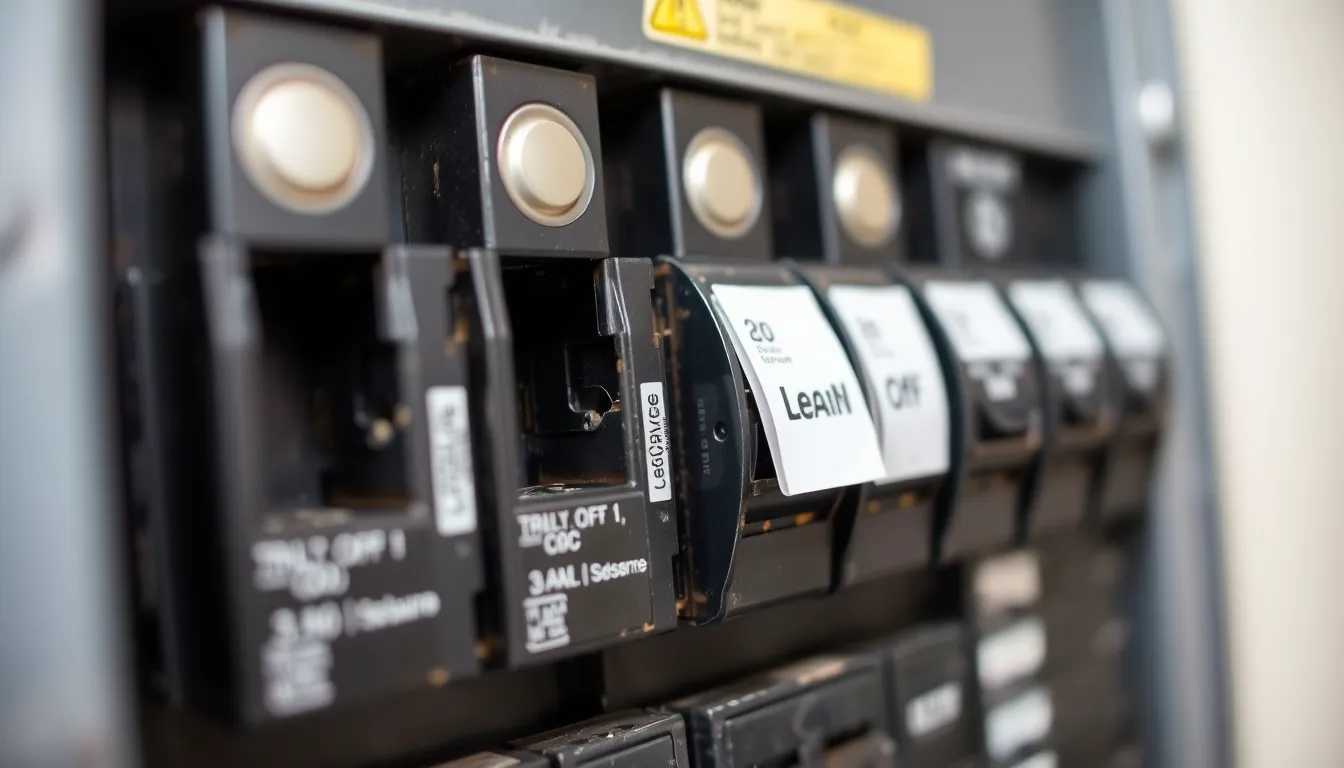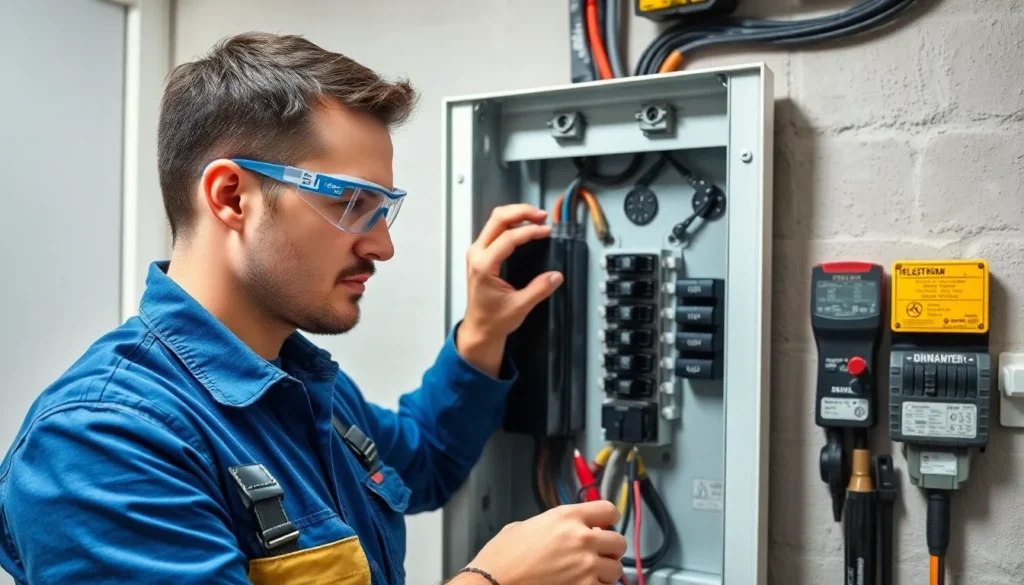Table of Contents
ToggleImagine this: you’re enjoying a cozy evening at home when suddenly, the lights flicker and everything goes dark. Your circuit breaker just pulled a disappearing act, and now you’re left wondering if it’s time to call in the professionals or channel your inner DIY hero. While the idea of wrestling with wires might sound like a thrilling adventure, circuit breaker repair isn’t exactly a walk in the park.
Overview Of Circuit Breakers
Circuit breakers play a crucial role in electrical systems. They function as safety devices that prevent electrical overloads and short circuits. Each breaker interrupts the flow of electricity when it detects abnormal conditions. These devices protect homes and commercial properties from potential fires and electrical hazards.
Various types of circuit breakers exist, including standard, GFCI, and AFCI breakers. Standard breakers manage general electrical loads, while GFCI breakers specifically protect against ground faults, which occur when electricity travels along an unintended path. AFCI breakers reduce the risk of fires caused by arc faults in wiring and electrical devices.
Ratings for circuit breakers indicate their maximum load capacity. They range from 15 amps for standard breakers to over 100 amps for high-capacity models. Understanding these ratings helps determine the appropriate breaker for specific applications. Installation often requires knowledge of local electrical codes to ensure safety and compliance.
Maintenance of circuit breakers is essential as part of a larger electrical system. Regular inspections can identify signs of wear or damage. Signs may include unusual noises, heat, or tripping more frequently. Replacing a malfunctioning breaker is vital to maintaining system integrity and ensuring safe operation.
Attention to circuit breakers directly impacts overall electrical safety. Seeking professional assistance for repairs ensures proper handling of hazardous conditions. Professional electricians possess the expertise and tools required for effective circuit breaker repair, minimizing risks for homeowners and businesses alike.
Common Issues That Require Repair

Several common issues may indicate a need for circuit breaker repair. Addressing these issues promptly helps maintain electrical safety and efficiency.
Tripped Breakers
Tripped breakers often signal an underlying problem within the electrical circuit. Frequent tripping indicates overloading, which occurs when devices draw more power than the breaker can handle. Individual breakers may trip when a fault develops in an appliance, causing a short circuit. Regularly checking for overloaded circuits can prevent recurring problems. In some cases, an old breaker may lose its ability to handle normal loads leading to frequent trips. Assessing the load requirements of circuits helps ensure proper breaker sizing. Seeking professional advice can clarify whether replacing the breaker is necessary.
Burnt Connections
Burnt connections are a serious concern within electrical systems. They typically result from excessive heat generated by loose or corroded connections. When connections deteriorate, they compromise the integrity of the electrical circuit, increasing fire risks. Inspecting the breaker panel for burnt connections is vital. Signs like discoloration or a burnt smell should prompt immediate investigation. Repairing or replacing affected wires and connections ensures safe operation. Neglecting these signs may lead to further damage or dangerous conditions. Understanding the importance of timely repairs keeps electrical systems functioning safely and effectively.
Steps For Circuit Breaker Repair
Repairing a circuit breaker requires attention to detail and a focus on safety. Follow these steps to ensure effective repair.
Safety Precautions
Start by cutting off power to the circuit breaker. Turn off the main power switch to prevent any electrical shock. Use insulated tools for protection against accidental contact with live wires. Wear rubber-soled shoes and safety glasses to safeguard against potential injuries. Maintaining a clear workspace promotes safety during the repair. Avoid working in damp areas where moisture can present hazards. Confirm that the breaker is cool before touching it to prevent burns from heat buildup.
Tools Needed
Gather necessary tools before starting the repair process. A multimeter helps measure voltage and ensure the breaker is disconnected. Use screwdrivers, both flat-head and Phillips, for removing the breaker and securing connections. Pliers assist in gripping wires for troubleshooting. An adjustable wrench can tighten or loosen any fittings during the repair. Electrical tape is essential for securing connections to avoid shorts. Having a flashlight on hand provides visibility in dark areas, ensuring a thorough inspection.
Repair Process
Begin the repair by removing the access panel to the breaker box. Unscrew the breaker tightly, and carefully pull it away from its connection. Inspect the breaker for visible damage or burn marks. If damage exists, replace it with a new breaker of the same rating. Connect the new breaker by securing it back in place and tightening the screws to ensure a solid fit. Additionally, check the wiring for any signs of wear or loose connections before closing the panel. After everything is secure, restore power at the main switch and test the circuit to confirm proper operation.
When To Call A Professional
Certain situations necessitate professional intervention for circuit breaker issues. Unusual noises, like buzzing or clicking, signal potential hazards. Frequent tripping occurs when a circuit is overloaded or when there are faults in connected appliances. Burnt or discolored connections indicate potential fire risks and warrant immediate action.
Professionals possess the expertise to diagnose complex issues. For example, if a breaker fails to reset despite following typical troubleshooting steps, consulting an electrician becomes essential. They can pinpoint problems beyond a simple repair, such as wiring faults or deeper electrical system failures.
Another reason to call a professional lies in safety. Handling electrical components poses inherent risks, especially without the right tools or training. In cases of visible damage, like melted plastic or exposed wires, trained electricians should assess the condition and conduct necessary repairs.
Local electrical codes often dictate specific installation and repair practices. Ignoring these codes can lead to legal issues or safety violations. Professional electricians understand these regulations and ensure compliance during repairs.
For those uncertain about completing repair tasks, hiring a professional alleviates anxiety. A skilled electrician provides a thorough inspection and guarantees that all work meets safety standards. Trusting experts to manage intricate electrical systems enhances reliability and prolongs the lifespan of circuit breakers and related components.
Knowing when to seek professional help is crucial for maintaining electrical safety. Promptly addressing issues minimizes risks and promotes a safe living environment.
Addressing circuit breaker issues promptly is vital for maintaining electrical safety. Understanding the intricacies of circuit breakers and recognizing when to seek professional help can prevent potentially dangerous situations. Regular maintenance and inspections are essential to catch problems early and ensure a safe living environment.
While DIY repairs may seem tempting, the risks involved highlight the importance of professional expertise. Electricians possess the knowledge and tools needed to diagnose and repair complex electrical issues effectively. Prioritizing safety and efficiency in electrical systems not only protects property but also enhances peace of mind.





